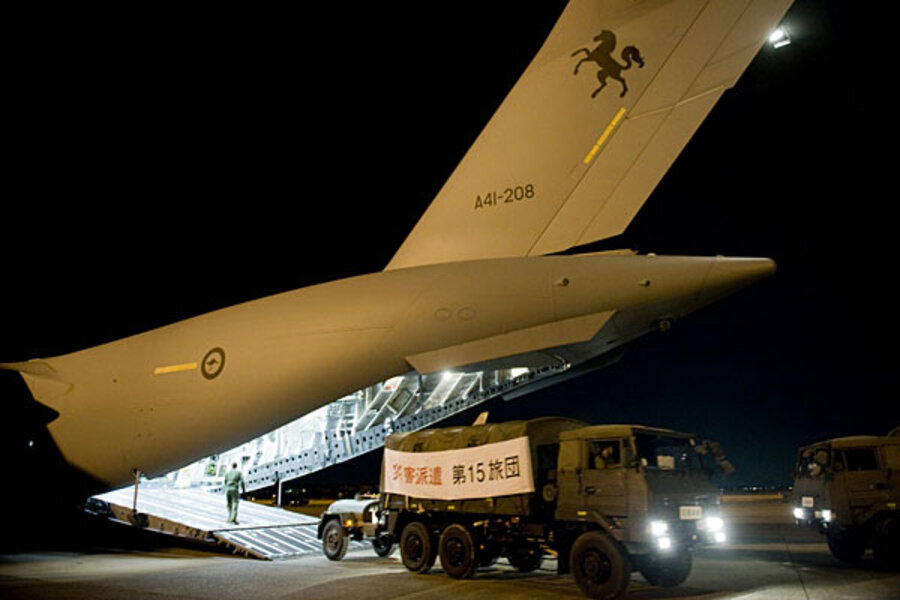Japan disaster relief now getting through to most survivors
Loading...
| Oshika Peninsular, Japan
Two vital things have improved for more than 250,000 evacuees still living in makeshift shelters a week after the Japan earthquake: supplies are getting through, and the weather has warmed up for now.
The Watanoha Elementary School, the ground floor of which was flooded by the March 11 tsunami, is home to some 1,000 evacuees from the surrounding Ishinomaki City area who spent the first five days there with no food or water supplies.
“We survived on snacks, cakes, and whatever food we happened to have on us for five days,” says Tomio Yamane. “It was so cold, we had no way of warming ourselves and people were getting no proper nutrition. It's amazing nobody died here at the shelter."
The resilient character of the Japanese people has been on international display for the past week as this nation struggles to regroup from the 9.0-magnitude earthquake and tsunami that erased communities and gave a blow to the economy. For many evacuees, there is now nowhere to go, and Prime Minister Naoto Kan has warned that "life in the emergency refuge centers will continue for some time yet."
"To everyone in the emergency refuge centers, I express my deepest sympathy for the hardships you are undergoing, in the cold, with meager supplies of food and water, and limited access to toilet facilities," Mr. Kan said in statement Thursday marking the one week since the earthquake. "At present, we in the government are working flat out to supply you with the food and blankets and other things you need."
Families reunited
With the ground floor of Watanoha Elementary School still damp and in disarray, the classrooms on the upper three stories have become cramped sleeping quarters, storerooms, and a basic medical room. Medicine is now arriving – the Marine Self-Defense Force has used the school playground as a helipad – and food and water is coming in by road. Communal meals are also being cooked in the playground using wood from the innumerable destroyed houses in the city.
“The ambulances and Army began to arrive after a few days and took the sick and weak to hospitals. There were 1,200 to 1,300 of us here at one point,” says Ms. Yamane.
Despite the tough conditions, Yamane's husband was happy to be there, having just arrived after a two-day journey from the Tokyo area. With no electricity or telecommunications lines open, he hadn't been able to confirm whether his wife and their two grown children alive were alive or not until he reached the shelter Saturday.
The scale of the disaster that has struck the region is hard to comprehend. The earthquake moved the coastline of Japan's main Honshu island eight feet and shifted the earth 10 inches off its axis. The latest official death toll as of writing is 8,450, with a further 12,931 people missing.
Tens of thousands have also been evacuated due to fear of a major radiation leak at the Fukushima Daiichi nuclear power plant, and many more left on edge across the country.
'Warm during the days now'
Fatalities and destruction spread across hundreds of miles of coastline, from Chiba to Hokkaido. Picturesque fishing villages formerly dotting the Oshika Peninsula were annihilated.
“I was working on the seashore, when I heard the tsunami warning on the radio,” says Masashi Abe, who farms scallops. “It said it would be three to six meters [10 to 20 feet], and I thought, 'really? We better get out.' ”
“Actually it was higher than that, up to 10 meters [33 feet] in places; you can see by where it left debris stuck up high in the trees,” says Mr. Abe, who has lived through previous tsunamis.
Still, he is relieved to have food and somewhere warm to sleep at night, though his evacuation center happens to be, of all places, the nearby Onagawa nuclear power station.
“There are no problems at that plant and we can get food from there that the Army and Navy have been bringing in from the air,” says Abe. “And it's warm during the days now when we are out trying to find things of ours that were swept away by the tsunami.”
Like most people along the peninsula, the Abe family is unable to move due to a nationwide gasoline shortage. They are spending their days sifting through the rubble that used to be their town in the hope of finding some memento of the life they used to lead.





